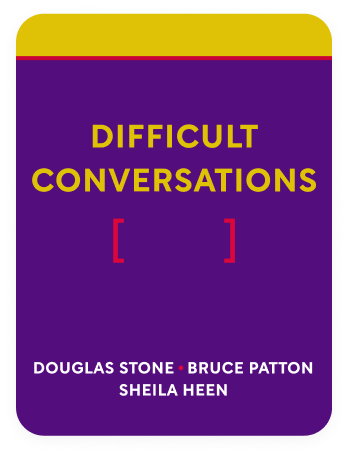

This article is an excerpt from the Shortform book guide to "Difficult Conversations" by Douglas Stone, Bruce Patton, Sheila Heen. Shortform has the world's best summaries and analyses of books you should be reading.
Like this article? Sign up for a free trial here .
When someone blames you, directly or indirectly, what do you do? How can you deal with blame in a constructive way?
When someone blames you, it’s really a code for three questions. Did you cause the problem? Should your actions be judged against some standard, and if so, what standard? Should you be punished?
Here is how to keep cool when someone blames you and resolve the matter in a constructive manner.
When Someone Blames You, Stay Above the Fault Line
Blame is about judgment and looking backwards. The issue of whether someone’s to “blame” is really about 3 connected questions:
- Did you cause the problem?
- Should your actions be judged against some standard, and if so, what standard?
- Should you be punished?
“This is your fault” is really code for yes to all 3 of those questions. When someone blames you, they explicitly put us in the role of the accused— so it’s no wonder we get defensive.
Even if you can answer the question of who’s to blame, it doesn’t usually help solve the problem. With blame comes punishment, and punishment comes at a cost — understanding and punishment don’t usually go hand in hand. When people are afraid of being blamed and thus being punished, they’re usually less likely to be truthful or open about the matter, and less likely to apologize, since it seems like an admission of guilt.
Blame also obfuscates when there are bad systems at play, bigger than a single person who can be blamed. But usually no one person is fully to blame.
- (Shortform example: We see this in corporations all the time — someone, usually a bigwig like a CEO, takes the fall for something that the corporation at large participates in. People want someone to blame, they blame the person in charge, they get rid of that person, then the system is allowed to continue in the same fashion.)
The Solution When Someone Blames You: The Contribution System
Contribution, on the other hand, is about understanding and looking forward. Contribution asks what we both did to get in this situation, and what we can do to get out of it together. The goal is to identify what contributions both parties made, and how each party’s reactions are part of an overall pattern in the relationship.
- Even though from our perspective the blame looks one-sided, in reality everyone has contributed in some way.For example, in baseball, think about a pitcher and a batter facing off. Whether the face-off results in a home run or a strikeout is the result of the interaction between the two individuals. You can focus on the actions of one or the other — the batter may blame his strikeout on his wrist injury; the pitcher may credit his fast-ball for the strikeout — but both party’s actions are required to make the outcome.
The contribution system is more likely to be productive and make the difficult conversation easier to have, because it promotes learning and change.
- For example, if a wife cheats on her husband, their marriage has a much better chance of surviving if they can use the contribution system — what did they both contribute to the situation that led to one of them cheating? — instead of the blame system, which will punish the wife but not address the issues that drove her to cheat in the first place.
There are, of course, some extremes and exceptions — even though both parties contribute, there are still some cases where blame is necessary. For example, if a parent abuses a child, the child might have “contributed” something, perhaps too much noise or misbehaving or mouthing off, but their contribution in no way warrants the parent’s contribution, and blame can be placed on the parent over the child.
3 Myths about Contribution
1. I should only focus on my contribution. False. You shouldn’t overlook the other person’s contribution — usually, we find ourselves in difficult conversations because we’re already aware of the other person’s contribution. Admitting your own contribution doesn’t negate the other person’s, and it’s possible they contributed more to the problem than you did: but whether it’s split 50/50 or 5/95, both parties contribute.
2. Putting aside blame means I have to ignore my feelings. False. Sharing your feelings is an essential component of contribution. Speaking more directly about your feelings and taking ownership over them can help lower your desire to blame the other person.
If you find yourself wanting to blame the other person, try asking, “What feelings am I failing to express?” or “Have they acknowledged my feelings yet?” Most of us would prefer to receive understanding and acknowledgement in place of a right to blame.
3. “Contribution” means the victim is to blame. False. Victims are never to blame. However, they can still explore how their actions contributed to the situation. If we want to empower victims, we need to look at the ways they can change their contribution in the future. We can’t change other people’s contributions to situations — changing our own behavior gives us some control over the situation.
For example, if you’re walking along the street at night and you get mugged, you’re not “to blame” for getting mugged. If we want to blame or punish someone, we punish the mugger. However, if you want to learn from the situation instead of just blame someone, you have to review how your actions contributed to the situation. This gives you power moving forward. Maybe you won’t walk along that street at night alone anymore.
4 Subtle Ways of Contributing
Spotting your own contributions takes time and practice, but here are four less obvious ways that we contribute to difficult situations.
1. Avoiding. We can contribute to a difficult situation by failing to address it before it goes too far. Sometimes, we put things off because we hope they’ll blow over on their own. Sometimes, we stay silent because we fear the repercussions. Sometimes we complain to third parties instead of confronting the person with our feelings — this might help us feel better in the short-term, but it doesn’t solve the issue.
2. Being unapproachable. Your system of dealing with issues makes people less likely to bring things up with you. This could be any number of different things — you could seem uninterested, argumentative, unfriendly. And though you might think it’s not your problem to make yourself approachable if someone else has an issue, that mindset isn’t going to help you solve the problem.
3. Intersections. Intersections are points where the assumptions of two parties are at odds. Intersections are caused by differences that result in friction between two people based on background, communication style, preferences, or other assumptions. When we treat intersections like these as matters of right or wrong, we fail to move past them. You’re not right because you come from a different background than someone else; they’re not wrong because they come from a different background. When we contribute this way, we’re usually hoping the other person will fundamentally change without us having to say anything.
4. Problematic role assumptions. A great example of this contribution is family patterns where less healthy ways of connecting have become the norm. For instance, a young boy might fall into the role of “trouble maker” to get attention; his mother takes on the role of nag, urging her husband to do something about the boy’s behavior, and then yelling at her husband when he yells at their son, who starts to cry. Although no one particularly enjoys these patterns, they’re familiar and comfortable because they’re so ingrained in us, so we all fall into these problematic roles the second an issue arises. We force each other to play parts that aren’t necessarily productive. Everyone would have to change in order to change the system — in this instance, we need alternative examples of how to solve issues.
Spotting Contributions
Spotting how you contribute to situations takes time and patience, and shifting how you see your own contribution and others’ takes work and practice.
Analyzing Your Contribution
People generally fall into 2 styles of analyzing contribution: they’re either shifters or absorbers.
If you are a shifter, you have a hard time seeing your own contributions — you shift the “blame” elsewhere, hence the name. When someone blames you—even if they are right—you tend to take the stance of a victim.
If you are an absorber, you focus too much on your own contributions— you absorb responsibility for both parties’ actions. When someone blames you, you tend to fixate on the negative consequences of your own actions.
Knowing your style can help you be more aware of it and can also help you start to shift your style to a healthier one.
2 Tools to Help You Spot Your Contributions
1. Reverse the roles. Ask “What would they say I was contributing?” Think about their answers and try to see yourself through their eyes.
2. Try to be an objective third party. Pretend you’re a neutral consultant called in to help. How would you describe, in objective terms without judgment, what both people are contributing? You can also ask a friend to weigh in on the situation.
Helping the Other Person
Even once you’ve worked to better spot and analyze your own contributions, you might still have some difficulty getting the other person to do the same.
When someone blames you, don’t get defensive and take responsibility. But do express it clearly if you feel like the focus is solely on you and your contributions. Help the other person understand their own contributions by being explicit about your reasoning. List what you see their contributions as. Be upfront about your observations. Discuss what actions and reactions are creating the system you both find yourselves in.
Clearly express what you’d like the other person to do differently. Tie it into your own contributions to help them feel less defensive — doing X next time will help me be better about Y. This cuts to the heart of the conversation system, what each person needs to change to improve the situation.
Remember, the goal is not to get an admission — the goal is to get a better understanding and discuss constructively what to do next.

———End of Preview———
Like what you just read? Read the rest of the world's best book summary and analysis of Douglas Stone, Bruce Patton, Sheila Heen's "Difficult Conversations" at Shortform .
Here's what you'll find in our full Difficult Conversations summary :
- Why healthy relationships need difficult conversations
- The 3 conversations that happen within each difficult conversation
- How difficult conversations go wrong and what to do about it






